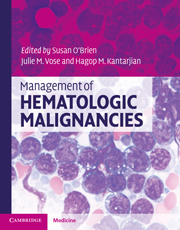Book contents
- Frontmatter
- Contents
- List of contributors
- 1 Molecular pathology of leukemia
- 2 Management of acute myeloid leukemia
- 3 Treatment of acute lymphoblastic leukemia (ALL) in adults
- 4 Chronic myeloid leukemia
- 5 Chronic lymphocytic leukemia/small lymphocytic lymphoma
- 6 Myelodysplastic syndromes (MDS)
- 7 Hairy cell leukemia
- 8 Acute promyelocytic leukemia: pathophysiology and clinical results update
- 9 Myeloproliferative neoplasms
- 10 Monoclonal gammopathy of undetermined significance, smoldering multiple myeloma, and multiple myeloma
- 11 Amyloidosis and other rare plasma cell dyscrasias
- 12 Waldenstrom's macroglobulinemia/lymphoplasmacytic lymphoma
- 13 WHO classification of lymphomas
- 14 Molecular pathology of lymphoma
- 15 International staging and response criteria for lymphomas
- 16 Treatment approach to diffuse large B-cell lymphomas
- 17 Mantle cell lymphoma
- 18 Follicular lymphomas
- 19 Hodgkin lymphoma: epidemiology, diagnosis, and treatment
- 20 Treatment approaches to MALT/marginal zone lymphoma
- 21 Peripheral T-cell lymphomas
- 22 Mycosis fungoides and Sézary syndrome
- 23 Central nervous system lymphoma
- 24 HIV-related lymphomas
- 25 Lymphoblastic lymphoma
- 26 Burkitt lymphoma
- Index
- References
8 - Acute promyelocytic leukemia: pathophysiology and clinical results update
Published online by Cambridge University Press: 10 January 2011
- Frontmatter
- Contents
- List of contributors
- 1 Molecular pathology of leukemia
- 2 Management of acute myeloid leukemia
- 3 Treatment of acute lymphoblastic leukemia (ALL) in adults
- 4 Chronic myeloid leukemia
- 5 Chronic lymphocytic leukemia/small lymphocytic lymphoma
- 6 Myelodysplastic syndromes (MDS)
- 7 Hairy cell leukemia
- 8 Acute promyelocytic leukemia: pathophysiology and clinical results update
- 9 Myeloproliferative neoplasms
- 10 Monoclonal gammopathy of undetermined significance, smoldering multiple myeloma, and multiple myeloma
- 11 Amyloidosis and other rare plasma cell dyscrasias
- 12 Waldenstrom's macroglobulinemia/lymphoplasmacytic lymphoma
- 13 WHO classification of lymphomas
- 14 Molecular pathology of lymphoma
- 15 International staging and response criteria for lymphomas
- 16 Treatment approach to diffuse large B-cell lymphomas
- 17 Mantle cell lymphoma
- 18 Follicular lymphomas
- 19 Hodgkin lymphoma: epidemiology, diagnosis, and treatment
- 20 Treatment approaches to MALT/marginal zone lymphoma
- 21 Peripheral T-cell lymphomas
- 22 Mycosis fungoides and Sézary syndrome
- 23 Central nervous system lymphoma
- 24 HIV-related lymphomas
- 25 Lymphoblastic lymphoma
- 26 Burkitt lymphoma
- Index
- References
Summary
Introduction
Acute promyelocytic leukemia (APL) is a distinct subset of acute myeloid leukemia (AML) associated with unique features and requiring specific management. The disease was initially recognized in 1957 by Hillestad, who described three patients with a rapidly fatal acute leukemia characterized by an abundant number of abnormal promyelocytes infiltrating the marrow and a severe hemorrhagic syndrome. In the following decades, APL has become a well-recognized entity, characterized as the M3 subtype of AML within the French–American–British (FAB) morphologic classification accounting for approximately 10% of cases of AML.
Clinically, APL is associated with a bleeding diathesis due to excessive fibrinolysis, which worsens during initial administration of chemotherapy. Most patients present with a low white blood cell (WBC) count, but 10% to 30% have a WBC count greater than 10,000/μL, with increased risk of serious and potentially fatal hemorrhages into the central nervous system and lungs. The disease is initiated by a malignant transformation of an immature myeloid cell followed by block in differentiation at the promyelocyte stage. The promyelocytes and blasts in > 95% of APL cases harbor a balanced, reciprocal translocation involving the long arms of chromosomes 15 and 17 that is often the only cytogenetic abnormality present.
In spite of being an infrequent disease, APL represents one of the most successful examples of translational research in medicine. Over the past two decades, considerable progress has been made in the treatment of this leukemia, such that it has been converted nowadays into the most frequently curable adult leukemia.
- Type
- Chapter
- Information
- Management of Hematologic Malignancies , pp. 131 - 140Publisher: Cambridge University PressPrint publication year: 2010



